State & Local Leadership Have Failed To Learn From Mistakes Of The Last 75+ Years
I’d like to think that after decades of leadership pushing projects that clear many acres of buildings, streets, sidewalks, utilities, etc., that someone in city hall or Jefferson City would realize that such projects are costly follies that never live up to the promises. Some examples:
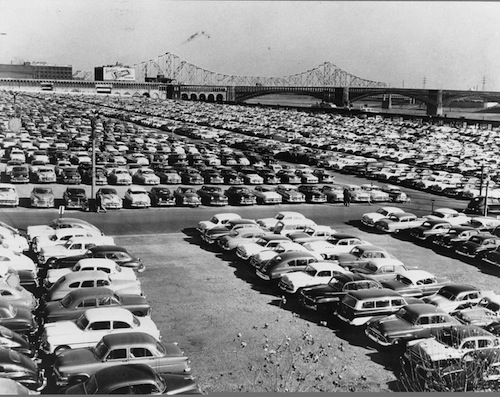
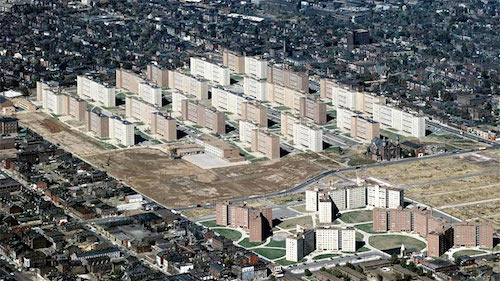
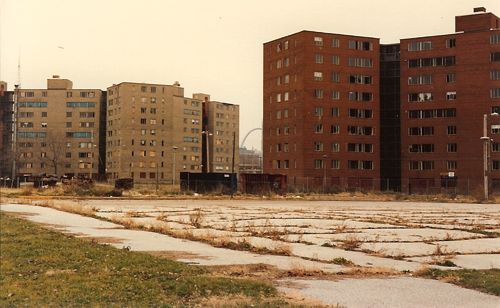
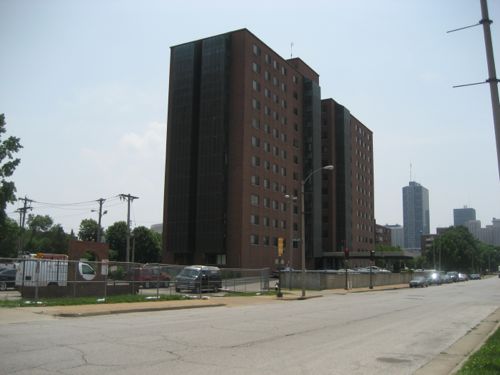
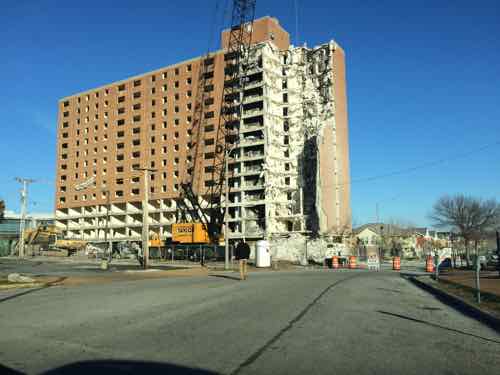
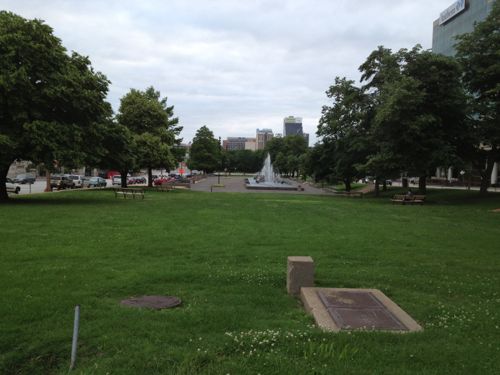
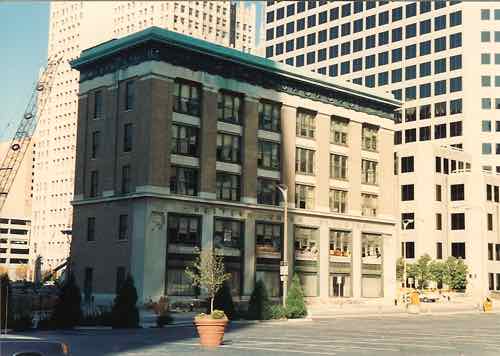
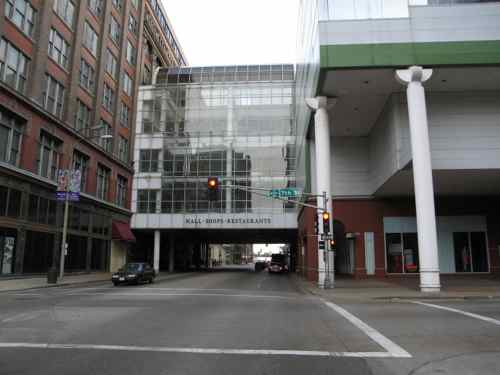
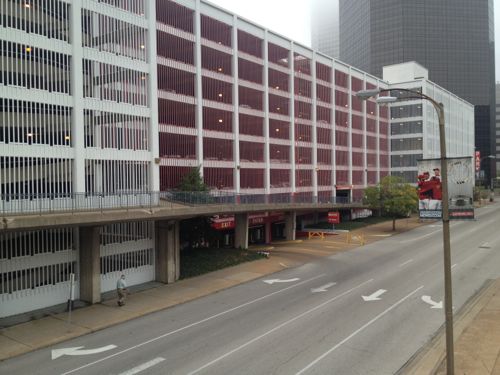
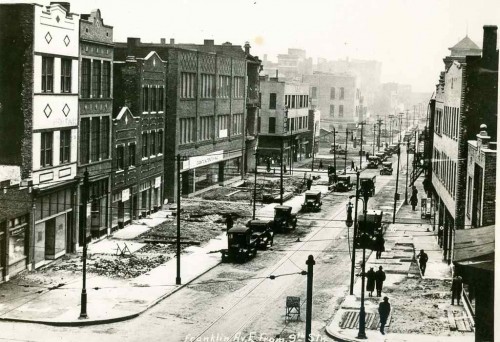
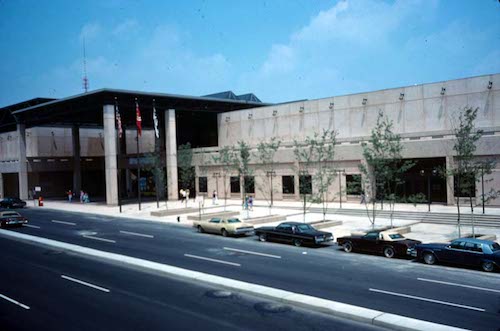
There have been countless other projects; including highways that separated neighborhoods, warehouses that destroyed the street grid, etc. In 1988 the city began discussing buying the Sheraton Hotel, located immediately east of the Cervantes Convention Center to expand and build a football stadium, the 600+ room hotel wasn’t even a decade old when talk began of razing it to expand the convention center and build a domed stadium.
As politicians smiled and sweated in Monday morning’s 89-degree heat, ground was broken for the $260 million stadium expansion of Cervantes Convention Center. The building, scheduled for completion by October 1995, will seat 70,000 for professional football. With 177,000 square feet of exhibit space on one level, it will accommodate events as large as national political conventions. During the hour-long ceremonial groundbreaking at Seventh Street and Convention Plaza, demolition crews began swinging a giant ”headache ball” at the old Sheraton Hotel, one block north. Each swipe at the 13-year-old hotel, which sits near the 50-yard-line of the stadium expansion, brought cheers. But the sturdily built hotel was slow to succumb to the headache ball. (Post-Dispatch Tuesday, July 14, 1992)
I was just 25 when demolition began on a tall hotel that wasn’t even 15 years old, but it was worth a couple of shots on my roll of film.
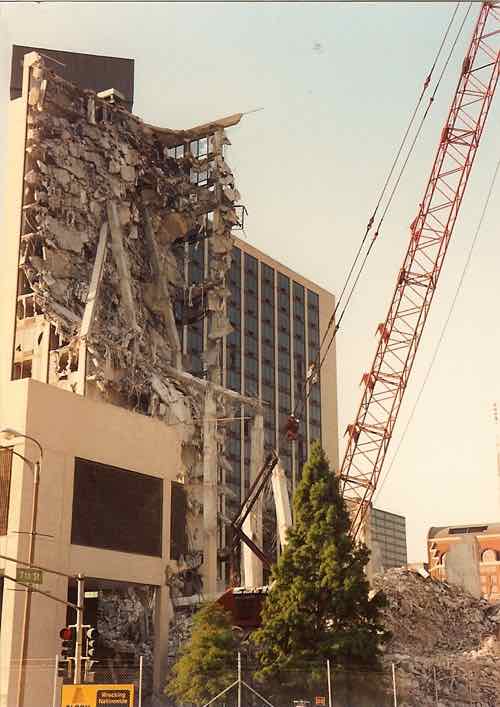
Razing the hotel built to serve conventions meant we had to build another convention hotel, the Renaissance Grand has lost money since opening.
“Insanity: doing the same thing over and over again and expecting different results”
— Albert Einstein
Tomorrow I’ll post about the particulars of the latest St. Louis folly: last friday’s proposal for a new NFL/MLS stadium to convince billionaire Stan Kroenke from moving the Rams back to Los Angeles.
— Steve Patterson
So . . . . absolutely any change is “bad”?! If someone hadn’t torn down some 19th century cabins to build a shoe factory, there wouldn’t be the building your loft is located in. We shouldn’t have moved from horse-drawn streetcars to electrified ones? We shouldn’t have spent money to install air conditioning in public buildings? We shoud rely on landlines? Because we don’t need cell phones? Police should walk their beats, use bicycles and call boxes? New Busch Stadium is worse than old Busch? And old Busch was worse than Sportsman Park? http://stlouis.cardinals.mlb.com/stl/history/ballparks.jsp
No one – not you, not me, not our leaders – given the clarity of 20/20 hindsight, will always make the “right” decision. Even your god, Steve Jobs, wasn’t always right. And it’s not just our “leaders” – there are multiple examples in the private sector of “bad” decisions – New Coke, shag carpet, hardboard siding, aluminum wiring, Yugo’s, vinyl roofs and donks are several that come immediately to mind. But that is how progress happens. We try new things. Some truly are better, some aren’t. I admit it, I tend to resist change, but I’m at least willing to let other people try.
The best we can hope for is that we do learn from our mistakes. Many, if not all, of your examples were not done maliciously; they were (and are) done with the best of intentions, and generally, with the support of the majority of the voters / residents. And the worst ones are rarely being repeated – large-scale “urban renewal” is a thing of the past, as is expanding the Interstate highway system. We won’t be building any more runways at Lambert and we won’t be destroying virgin forests and burying rivers to create a world’s fairground anytime soon . . . .
Where did I say any change is bad? St. Louis razed its exposition hall but replaced it with the Central Library by Cass Gilbert in 1012 — an example of good change. We reused millions of square feet of warehouse space for office and residential, also good change.
The bad change I highlighted today is from the Harland Bartholomew school of thought — scrape the earth bare to remove and and all evidence of an earlier time, build something new to be driven to/from — folly!
The flaw in your argument is context. What the majority of the citizens, here and elsewhere, wanted from their leaders in the 1940’s, 1950’s and 1960’s is different than what people want from them, today. There’s a tendency for every generation to be dismissive of the styles that were popular 40-50 years prior. People in the ’50’s and ’60’s thought that what was done in the ’10’s and ’20’s was stupid/wrong, just like how people in the ’90’s and ’00’s thought that what was done in the ’50’s and ’60’s is stupid/wrong. In 2060, assuming that self-driving cars are as prevalent as the “experts” predict, we’ll be looking back and criticizing public investments in modern streetcars and light rail systems!
If we hadn’t obliterated the street grid on the riverfront, we wouldn’t have the Arch. If we had continued the original city street grid, uninterrupted, west and south, we wouldn’t have Forest Park or Tower Grove Park. One size does not fit all. Building 4-6 story mixed-use buildings on every block in the city is not “the answer”. And, many times, change IS good, it is an improvement. You may view the Gateway Mall and an expanded convention as poor choices, but many other people would disagree. We each get to vote, and none of us will ever be totally satisfied!
Bartholomew wanted to raze Soulard, all of it. He and his contemporaries, like NYC’s Robert Moses, hated urban cites. They misunderstood the problems, thus prescribed the wrong solutions. The public accepted the advice of the experts, the patients nearly died as a result.
I wasn’t alive in the 40s or 50s, and didn’t arrive in St. Louis until August 1990 — but that gives me nearly a quarter century of context in St. Louis. Far more than you.
I publicly argued with Donald Royse about razing historic buildings for more passive green space plan in the library at the top of the Civil Courts building. I photographed a 13 year old hotel being razed for a stadium with the hopes of winning an expansion team.
I’ve studied it in grad school and lived it, blogs didn’t exist back then or I would’ve documented what I saw.
The post reminds people of past decisions and some of the context.
I was born in 1953, I remember the the last half of the ’50’s and all of the 60’s. The context, back then, WAS different than it is today. Construction, especially residential and commercial construction, had ground to a halt when the Depression hit in 1929, and didn’t start to recover until after WW II, approximately two decades later, in the late ’40’s. The old stuff was old and crowded, and the new stuff, mostly in the suburbs was more attractive, especially to the “Greatest” and Baby Boom generations that were created when all those GI’s returned home. Surface streets and highways were crowded, slow and, to many, outdated. Freeways were, new, faster, safer and provided connections to suburban living. My grandparents, like many others in their generation, in Chicago, moved from apartments to single-family homes, further out. My mother’s parents had a winter place in Ft. Lauderdale, while my parents and aunts and uncles had a series of suburban, single-family homes (because they could!) and I spent time in and with all of them.
Yes, some of Bartholomew’s and Moses’ goals look misinformed, given the clarity of 20/20 hindsight. But Soulard in the ’50’s is not the Soulard of today. Victorian mansions had not been renovated and there wasn’t a Mardi Gras or an active nightlife scene. It was an area the housed poorer residents in marginal conditions, and “in the 1970’s, it was a straight-up slum”: http://www.stlouiscitytalk.com/2010/06/soulard-neighborhood.html . . One option was demolition, another was gentrification – we all know which one won out. And, no, I don’t have the same context that you have with St. Louis (being here “only” 10+ years), but I have been involved in planning, design, community activism and even (successfully!) elected office, primarily in Denver, and I’ve “lived it” longer than you have! The challenges, issues and options here aren’t that much different than those found in Denver, Salt Lake City, Louisville, Detroit, Kansas City, Cincinnati, Pittsburgh or Memphis. The suburbs are “boring” and continuing to grow and sprawl. Certain older, urban neighborhoods and inner ring cities have been rediscovered and are gentrifying. Other urban neighborhoods and inner ring cities have remained fairly stable while others have declined and continue to decline. Urban freeways scarred older neighborhoods and sucked jobs out of the core, but most people in the ’50’s , ’60’s and ’70’s were buying that dream. Public transit remains a challenge. Older buildings are disrespected, especially if they don’t appear to have viable, current uses.
Don’t like it? Look to to your ancestors, your parents, your grandparents, your aunts and your uncles. They’re the ones who bought into the American Dream in the suburbs, they enabled the shopping centers and the auto dealers that hastened the decline of the urban core and urban transit. You want to blame our “leaders”. Guess what? WE are the leaders. WE elect the people who set the policies and define the priorities and the budgets. WE buy into the city (or the suburbs), WE own cars and don’t use transit. WE shop at the Apple store and Whole Foods and Target and Trader Joe’s IN THE SUBURBS. You want to point out what’s “wrong”; I’d rather figure out what works. And Adam, if “nothing was destroyed” that’s giving suburban sprawl carte blanche! Cities are NOT museums, frozen at some arbitrary point in time. They’re ALWAYS evolving, in respone to many, ever-changing inputs. Will “mistakes” be made? Absolutely! But there will also be many, many successes. And, as you all grow older, you’ll likely get less dogmatic in your thinking, as you observe the changes decades bring, both good and bad. Hubris is great if you’re posting on a blog; it’s less useful if you want to actually get things done!
Bartholomew & Moses were both born in the late 19th century, they and others of their generation influenced those born in the 1920s-40s, in particular at the 1939 World’s Fairs in NY & SF. This influence from men born in the 19th century helped build the anti-city movement of the 50s & 60s.
I fully understand the evolution of American cities and the contexts/influences in each decade. I also know that not all cities embraced the same policies. Same historical context, same problems — different solutions.
There are many, many influences in every decade. Blaming these two men for “the anti-city” movement is an over-simplification. Nothing in politics is ever truly the responsibility of any one person, good or bad, it’s group effort by like-minded individuals. As Americans, we tend to be always be searching for something better. The city and working in a factory was better than the uncertainties of life on the farm. The freedom of a private car was better than relying on public transit. Flying was quicker and better than taking the train. A single-family home in the suburbs was better than paying rent for an apartment in the city. Urban design and government investments reflect those individual choices at those points in human existence. Yes, now that we have lived with those choices, SOME people are (continuing to?) questioning the wisdom of (some of? all of?) those choices. But I take exception with your headline that “State & Local Leadership Have Failed To Learn From Mistakes Of The Last 75+ Years”. It implies that our leaders are stupid, that they don’t realize that “mistakes” are being made, and that they don’t care. While I don’t always agree with every decision our elected officials make, I’m not going to accuse most of them of gross incompetence.
The gensis of this post is obviously the plans announced last week for a new NFL stadium. While these plans were generated by a small group created by the governor, I certainly don’t look at them as our only “leaders”. They put a plan on the table. It has flaws. It has some positives and it has some negatives. It has certainly generated discussion. But, it’s also far from “final”, so blaming all our state and local leaders of a “failure to learn” (or lead) is a gross over-simplification! By it’s very nature, an NFL stadium is not going to fit well into ANY traditional urban street grid. We can argue whether the government should even invest in (another new) one and we can argue about where it should be located. But dragging up images of buldings being demolished, for whatever reason, good or bad, and implying that all of our current leaders have repeated or will repeat these indignities against the urban fabric is a pretty big leap.
What’s over simplified is your thinking that in 1950 things suddenly changed, they didn’t. In the 1950s/60s many things came together.
Much of the reason for this change started on March 25, 1911 — the Triangle Shirtwaist Factory Fire got the attention of the public that lived far away from big cities and factories, http://en.wikipedia.org/wiki/Triangle_Shirtwaist_Factory_fire. This combined with efforts to improve living conditions for new immigrants living in crowded tenements.
Bartholomew & Moses were two who helped guide & write federal urban renewal legislation that would transform cities in the 50s/60s. Bartholomew was so broadly influential, his firm wrote the zoning codes for hundreds of cities, many their first zoning ever — I know because I’ve sat in the Washington University archives going through box after box of them.
In 1950 he left St. Louis after 30+ years to work in — Washington D.C., where he’d become established over the prior could of decades.
Yes, there’s lots of context!!
I realize that under the new urbanism it is not proper to point
out that many of the old buildings demolished under the urban
renewel phase were cold water flats with outdoor privies. Maybe
the outside was charming to some, but life inside was very
unpleasant.
This has nothing to do with ‘new urbanism’, those who pushed urban renewal threw the baby out with the bath water. If old flats couldn’t be updated you replace the building — not remove the road, sidewalks, and evey building in a huge area.
The problem, of course, is who goes first. If there is a block
of obsolete buildings, no one owner will replace his building
since he does not know if all or many owners on the same block
will do so. So if the goal is to replace obsolete housing, some
approach needs to be done to ensure that all will do it. One
approach is code enforcement, difficult with really old and
bad buildings. The other approach is to do everything at once
using eminent domain to force reluctant owners to act, and
replacing all buildings at once. Those were the elements of
the urban renewal program. In retrospect of course, it created
other problems so has not been much used in recent years
There is a book written by Ron Fagerstrom, “Mill Creek Valley, a Soul of St. Louis” in which he looks at the destruction of the Mill Creek Valley community. The people living in this area very much loved it, it had the usual corner stores and community fabric. Ron interviewed former residents of the area for the book. He also documented the assault by the leadership establishment who portrayed the area as you do in your comment. The Post Dispatch was a main vehicle for disseminating this opinion which lead to the destruction of a vibrant and vital neighborhood.
By the way I had some cold water flats in Soulard a few years back that had modern plumbing added at some point, you didn’t need to do a major renovation to add a bath, hot water and a kitchen, while not perfect in the modern sense it made for comfortable flats. So alternatives were available.
I see you studied various cities and had plenty of statistics and charts, did you ever bother to get off your ass an interview the people actually living in these neighborhoods that you so roundly condemn?
And what in the hell is new urbanism? Another label in an attempt to make the desire for better cities demonic?
yes, I worked in many urban programs over
the years and talked to many persons who
lived in the neighborhoods I described. Most
moved out when they had the money to do
so,
The main reason people stayed in Mill Creek was racial segregation
of housing in most of St Louis, so there was limited opportunity
to live elsewhere. You didn’t need the Post-dispatch to tell you about
Mill creek . Up until the 1950s, it contained major streets such as
West Pine for traffic to an from downtown and the West Endd
I agree with Jz71’s basic point that it is more the collective acts
of hundreds of thousands of individuals that created the suburbs and
lessened the density of the cities. The response of the “leaders”
was simply an attempt to grapple with the consequences of these changes. Few of the contributors to this forum recall the tre-
mendous traffic jams of the 1950s, which were to a great part relieved by the new highways of the 1960s and 70s. Few apparently remember the premises of urban renewal, which was that new in-
vestment could not be attracted piecemeal into blighted areas, but a
substantial clearance was needed.
Blaming “leaders” of a selfish power elite is a reflection of the
shallow thinking which dominated sociology departments in the
1950s and 1960s and which has continued to influence thinking
on urban issues to this day
excellent post. When I was an urban affairs prof at SLU in the early
1970s, we studied population change in seven midwestern cities.
including pittsburgh, chicago, detroit, cincinnnati, Cleveland, We
found that all had the same population and housing decline if one
compared neighborhoods of similar age. Since st Louis had a greater
percentage of areas built before 1900, it had the greatest per cent
drop in occupied dwellings. In all cities, people were moving out of
old multi family buildings. In all cities, there was a equivalent of
the central west end. In all cities , highways were being built. In
all cities, areas near large hospitals and universities were im-
proving. The upshot was that st louis was, on average, doing no
better or no worse than other cities
JZ, disagrees? WHAAAAAAAAAAAAAT!!!???
“If we hadn’t obliterated the street grid on the riverfront, we wouldn’t have the Arch.”
Bullshit. The arch could have been built without leveling 40 square blocks. The vast majority of those blocks weren’t even leveled for the Arch. The Arch was an afterthought. They were leveled because they were deemed “obsolete”.
“If we had continued the original city street grid, uninterrupted, west and south, we wouldn’t have Forest Park or Tower Grove Park.”
Not continuing the streets grid is not equivalent to obliterating the existing street grid. In the former case nothing was destroyed.
“You may view the Gateway Mall and an expanded convention as poor choices, but many other people would disagree.”
Who are these “many other people”? How do you know these “many other people” wouldn’t have been happier with the existing fabric? There were no public votes on the construction of Busch 2, Cervantes, etc.
World renown architect Steven Holl http://www.stevenholl.com suggested at one point he would have maintained the historic riverfront and had the arch rise out of the urban fabric. It would have been a sensational solution. Right now much of the Arch park is basically useless open space, barely a step above a vacant lot. Holl is an innovative and creative architect that finds solutions.
And yes the street grid is interrupted by parks, it happens often and has nothing to do with obliterating the existing street grid. Central Park in New York comes to mind as a famous example that is not St. Louis.
In short it wasn’t necessary to destroy the street grid to build the Arch.
But if the street grid had not been obliterated, would there have ever been an Arch? YES, the land assemblage was highly controversial – http://en.wikipedia.org/wiki/Gateway_Arch – but without a site, would there have even been a competition? More likely, we would have ended up with “just” a historic marker, and not a national monument. While the loss of the old buildings is certainly debatable, the bigger question is what would represent Saint Louis if there were no arch and no Jefferson National Expansion Memorial? Would it be Lindbergh’s plane, the Spirit of St. Louis? Budweiser? The Checker Dome? City Hall? Union Station? Without the arch, we’d be just another aging river city.
http://www.new-madrid.mo.us/images/pages/N73/Historic%20Marker%201_thumb.jpg
Ever seen the eifell tower in Paris rising out of its park?
Or the Washington monument on the Mall?
There is a vast difference between the Eiffel Tower in Paris and the Arch grounds. It is like you are comparing a Ford pinto that doesn’t run to a new Mercedes Benz that has the latest technology. Did you know anything about the Eiffel Tower at all? It is a far superior urban space over the arch, served by numerous metro stations, buses and surface rail. The Arch and Arch grounds are not even a close comparison
In my last visit to Paris in 1994, the Eiffel tower was in fact
in a large open space and as I recall behind was a long mall
running for several blocks. Has this changed?. I was simply
pointing out that your suggestion that the Arch arise right
from adjacent buildings would obviously change the nature
of the arch, just as surrounding the Eiffel tower with buildings
would change its dramatic appearence
It was not my suggestion, it was Architect Steven Holl’s. I do think it would have been an interesting solution. Effiel Tower and the Arch have a few things in common, interesting monuments, green space surrounding and adjacent to a river. The difference is that the Effiel Tower is integrated and connected to the surrounding city creating an urbanism and quality of life for residents and visitors alike. In contrast, the Arch after 40 years it was determined that the urban planning status quo wasn’t working and million upon millions are being spent in attempt to correct the deficiencies.
If in fact the existing district was left largely left intact as Mr. Holl suggested then it could have possibly help provide the urban environment that surrounds the Effiel Tower, and that is lacking around the Arch. This is especially true if the highway that tore through the downtown area had been located elsewhere.
The convention center was rejected by the voters the first
time, but was approved by the voters the second time(I
worked on the second campaign). Busch 2 was partly paid
by a bond issue for street improvements etc approved by
the voters
I don’t think the point was “change is bad” rather the hubris of leaders and their inability to learn form mistakes is the problem. They’re easily seduced by the big shiny new thing.
Don’t forget about the highways
An amazingly poor history of decision making. The problem is they are still tearing up the city in smaller ways. The ignorance is mind blowing. You would think that after all of this time city officials would figure out that they don’t know what the hell they are doing and rethink their whole approach. There are many successful cities to learn from.
I agree the way highways were cut through St. Louis is a disaster. If i’m not mistaken a planner from Boston was responsible for much of the damage.
Every city in the country has highways cutting through. Why is St Louis any
worse?
Are you familiar with other highway systems at all? Yes they can vary in quality, with St. Louis on the low end of the scale. Take Chicago for instance, their highway does not cut through the heart of downtown dividing it into two.
In contrast in St. Louis the highway through the heart of downtown is now going through a redo to create better connections to the Arch grounds, although it too is an inadequate solution. Some have called for removal of the highway altogether, which probably would have been the best solution.
Basically the urban planning in St. Louis is spectacularly incompetent and has been for decades, and when coupled with corrupt insiders, whose motto is I got mine it harms the quality of life in both the city and the region.
A perfect recent example is Paul McKee and his secret plan for the Northside. A plan that should be transparent and be part of a larger discussion on how to build a St. Louis of the future. Instead it is the usual crap that has kept St. Louis in a downward spiral for so long.
I have traveled in most metro areas and have also reviewed
highway maps of those areas. Nearly all have highways running
through the city. Your example of Chicago has Lake shore drive
dividing it from the lake; the Interstate 55 running right through
the south side of the loop and the Kennedy=Ryan just west of loop.
All go through residential areas in other parts of town. Or look
at NYC, with highways crossing the Bronx, Brooklyn and
Queens. Or LA–enough said. Detroit has highways into downtown,
as does Pittsburgh. DC has highways running through residential
areas in Virginia. Take out your rand mcnally atlas and take a
look at these and other metro areas. On another of your
comments, exactly who are the “corrupt insiders” and exactly
which highways in st Louis did they specificaly set the route
for
Although the all-powerful corrupt establishment usually prevails. As I said previously the quality of highway layout varies across the nation. Lakeshore Drive is not a highway that was introduced later, and again, as you notice Chicago left downtown intact when introducing a new highway. The problems with the current downtown highway in St. Louis are evident and millions of dollars are currently being spent to correct the problem.
If you do not understand that most decision making is determined by insiders based on the amount of money they can shove in their pockets and not by serving the interests of the people then you are missing reality.
False argument – every American city with a river (and that would be pretty much every city) has a freeway that parallels their river, even Chicago. In Chicago, the Kennedy Expressway parallels the North Branch of the Chicago River, out of the Loop, and the Stevenson Expressway parallels the South Branch for miles! I-44, here, “does not cut through the heart of downtown dividing it into two”, but it does separate the heart of downtown from three things, the casino, the Arch and Laclede’s Landing, none of which are “the heart” of our business district.
And not to sound too snarky, if “urban planning in St. Louis is spectacularly incompetent and has been for decades, and when coupled with corrupt insiders, whose motto is I got mine it harms the quality of life in both the city and the region”, why do you even continue to live here?! Why not seek out other cities that do “do it better”? St. Louis wasn’t my first choice for a place to call home, and I can certainly see many of its flaws, but I don’t view them as falling to the level of outright incompetency and corruption, nor being particularily that much worse than any other city. We’re a democracy, and we, as a community, get the competency that we tolerate, and corruption seems to be exposed and prosecuted, around here, on a regular basis, primarily outside, and not inside, the city.
St. Louis’ primary challenge, as both a city and a region, is economic. It’s a rust belt city with all the baggage that that carries. Many people, if given the choice, choose to move to other, growing, cool, hip, cities. It takes people choosing to live and work someplace, any place, to create a community. It takes a growing population to justify new construction. It takes people wanting to live in urban densities to justify urban densities. People don’t move to Dallas or Austin or Minneapolis for the weather or the recerational amenities. People do move to Miami, LA and Denver for the recreational opportunities, but soon figureout that working full time limits the time you can actually do fun things with the throngs of fellow fun seekers.
There will always be someone else who does “something” better; there will also always be people who do it worse. Railing about incompetence and corruption, without becoming a part of the process (to actually change things, not just bitch about them), is easy, especially on the interwebs and blogs, but it DOES NOTHING TO CHANGE THINGS!!! Yes, saying things suck helps define the problem(s). But if you really want to change things, for the better, let’s focus on the art of the possible, the many small steps that need to happen, not grand, broad-brush indictments. Let’s push for more public participation on McKee’s plans – if he wants our money, we should have a voice. But realize, too, that “having a voice” and seeing every one of your ideas implemented are two very different things . . .
For you the art of the possible is to accept the crap the way it exists. You don’t think decisions that are made don’t have roots in incompetence, and/or corruption then you should study the history of St. Louis. And yes discussion on the blogs is not bitching but exposing, talking, discussing, you know, as in democracy. I have offered numerous potential solutions in the past. And who in the hell said I want every one of my ideas implemented, you just make shit up.
Finally the incompetence of the governance is currently on full display as over 100 million dollars is being spent to attempt to correct the poor choices made in building the arch. You say the highway didn’t impact the heart of St Louis? Again you are wrong and making absolutely no sense, the highway cuts through a critical part of downtown and efforts to correct it show the problem clearly, do you get it, do you understand? I guess not.
No, most decisions do NOT have their “roots in incompetence and/or corruption”, they have their roots in good intentions. Sometimes they work out well, sometimes they work out poorly. Every decision has its roots in balancing priorities, sometimes wildly divergent priorities. What you view as incompetence, corruption, poor planning or an outright lack of planning is, in reality, in St. Louis, as in many other rust belt cities, political leaders grappling with a shrinking population, a declining tax base, changing priorities among the voters, changing population demographics and a shitload of legacy costs in deferred infrastructure maintenance, underfunded pensions and too many people who don’t get that we’re no longer the most important part of the region, state or the nation!
Okay lets cover a few things
The Arch is experiencing an over 100 million dollar in upgrades in part to overcome defects in urban planning.
The Edward Jones dome lease is the result of bad negotiations, but also Dave Peacock cited in a Post article the poor design of the stadium which does not allow for improvements and upgrades, such as Arrowhead stadium in Kansas City and other stadiums.
Then there is Paul Mckee on the northside and the lack of transparency. The issue of the quality of life is important, but also the question of the future of cities and what they should look like in an age of global warming and energy concerns
Finally there are the numerous urban renewal projects most now demolished that where complete failures.
So take your pick: corruption, incompetence or stupidity. None of these and many other issues fit your grappling with shrinking population, underfunded pension doublespeak. I don’t see a city being built on good intentions, as Steve points out the same type of mistakes keep happening over and over, something else is in play, and it’s not good intentions, the city would look much different that was the case.
You must be a lot of fun at dinner parties.
The “I lived here longer than you” schoolyard jab is a real sign of an well-crafted argument, too.
It’s better than your nonexistent argument.
It’s also pretty hilarious that you, of all people, are chastising Steve for schoolyard jabs considering almost every one of your comments is a one-line disparagement.
Noted.